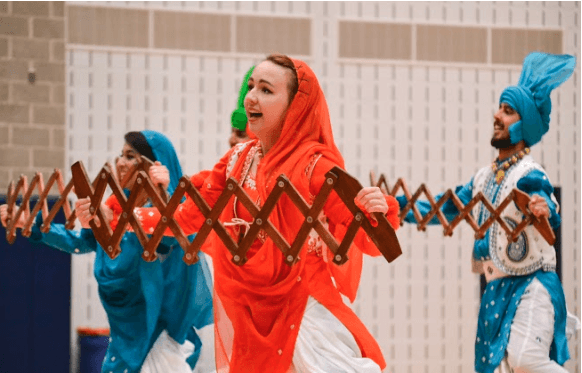Bhangra Beat steps up the competition
2 min read
Ginny Clark/The Blue & Gray Press
By GINNY CLARK
Smiles wide and knees high, bhangra teams from all over the state brandished their very best choreography in the 10th annual Bhangra Beat on Nov. 22. Hundreds of students, faculty and families filled the Anderson Center that night to view competitive performances from Virginia Commonwealth University Bhangra, University of Virginia Di Shaan, Virginia Tech Bhangra, James Madison University Bhangra and William & Mary Dhamaal. University of Mary Washington Eagle Bhangra did not compete but performed as an exhibition team.
Hosted by the International Living Community, the event revolves around bhangra, a dance brimming with energy, life and jubilation. While bhangra originates from the Punjab region of northern India and eastern Pakistan, the dance has since transformed to combine elements of pop, hip-hop and rock. Over the past decade, bhangra has become an essential and much loved tradition at UMW. Bhangra honors the multicultural community within our school and celebrates the diversity of our student body.
Framar House residents Kevin Sol and Robert Kingsley emceed the event, providing charming banter and needle-sharp wit. Fellow Framarian Zaïre Sprowal conducted the raffle in between acts. Prizes included a DVD of “Frozen,” a UMW scarf, a game of “Apples to Apples” and several other enticing rewards.
Over the course of the competition, different teams showcased distinct styles and techniques. VCU Bhangra, for example, began their act with a rap. William & Mary Dhamaal, UVA Di Shaan, VT Bhangra and JMU Bhangra incorporated sapps into their acts. The sapp or chhikka is a kind of instrument that folds and extends in an accordion-like fashion. Initially used to cut crops, the sapp pays homage to the heritage from which it originates. When slapped together, the wooden instrument produces a loud clap sound that punctuates the rhythm of the song.
Some teams also used khundas in their acts. Not unlike a marching band baton, the khunda is a hooked staff used in bhangra to augment the visual element of the performance. Raised, lowered, twirled or pointed, the khunda greatly enhances the aesthetic of the dance.
As the judges tallied up scores to determine the outcome, Kristen Tuxbury played the djembe, a type of drum originating from West Africa. Having spent some time with Americore in Mali, Tuxbury spoke on the social importance of the djembe in daily work, in celebration and in grievance. Tuxbury then proceeded to tell a traditional Malinke folk tale while expertly playing the drum.
After Tuxbury’s act, the top three teams of the competition were announced. VCU Bhangra earned third place. VT Bhangra landed their spot in second. Finally, first place was awarded to JMU Bhangra. After the event, performers and their friends celebrated at Taj, a local restaurant in Central Park.










